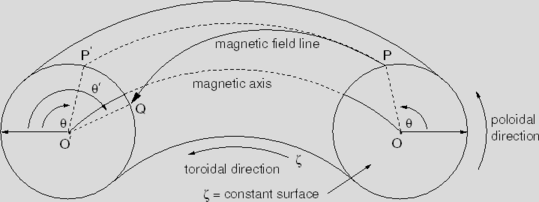Guiding Principles
Magnetic Confinement devices work to typically achieve a Deuterium-Tritium fusion by super-heating the two isotopes of Hydrogen within a chamber in very clever ways.
Firstly, the Hydrogen inside the reactor is intended be heated to a temperature upwards of 150,000,000 degrees Celsius before ignition of the fusion reaction.
No materials exist on this Earth which can withstand structural integrity at these temperatures. Before the gas enters a superheated state, however, it will
absorb a very large amount of energy and become ionized. When it reaches this state, it should no longer be classified as a gas and instead be classified as
a plasma. Plasmas are classified as raised to an energy high enough to be ionized, and thus carry charge. Since the superheated plasma then carries an electric charge,
it will experience a force when moving through the presence of a magnetic field. No matter the variety of reactor, magnetic confinement reactors are lined
with a current-carrying coil which induces a magnetic field within the shape of the space the plasma moves through. The aim of this is to generate a magnetic field
such that the superheated plasma is directed in a path that will not come into contact with anything but itself, working around the fact that no material can confine
the plasma. This magnetic field also induces an electrical current within the plasma itself, which will further energize the plasma until it reaches the right
temperature and pressures for an extended and controlled fusion reaction. The most promising and currently researched magnetic confinement reactor design at
the present appears to be the Topamak, although there are several other designs that have been proposed. The most striking difference between different
magnetic confinement reactors is the shape of the plasma-containing chamber, the guiding magnetic field geometries, and also methods of heating the plasma.
The Tokamak Design
The tokamak (toroidalnya kamera ee magnetnaya katushka) reactor is the most widely researched magnetic confinement reactor and most promising candidate
for power-yielding fusion. First concieved by Soviet researchers in 1951, the definitive feature of the tokamak design is its symmetric, toroidial (doughnut shaped) shape
and use of perpendicular magnetic fields to guide charged gases with one helical (spiral-shaped) field. One magnetic field is provided by a set of external
current-carrying coils along the reactor's toroidal shape to induce a magnetic field along the axis of a toroid. The second field, called the poloidal field,
originates from a current induced in the plasma by a changing magnetic field originating from a solenoid in the doughnut hole. The current induced in the plasma
can exceed one million amperes. The high electrical current in the plasma will create a large resistance that increases the overall temperature of the
plasma, but only to the point where an increase in plasma temperature will no longer cause an increase in resistance in the plasma. High energy beams of
neutral atoms and high energy electromagnetic waves are shot into the plasma to add energy to the plasma and heat it beyond that point. The greatest
advantage from the use of this reactor comes from the fact that the magnetic fields serve to increase the temperature of the plasma confined by the
reactor. However, its development has stunted by losses of plasma confinement arising the limiting amount of variables that can generate the reactor's
magnetic field.
Pictures are worth a thousand words when discribing the usd by a Tokamak. The following pictures could be a help for visualization.
"
 |  |  |
| Profile view displaying poloidal and toroidal field orientations. | Another profile view | A diagram representing the helical resultant field from summing the toroidal and poloidal fields. |
The Stellerator Design
Although slightly more obscure in present research projects than the tokamak, the stellerators are a magnetic confinement fusion reactor designs which works
on slightly different principles than the tokamak reactor. Both reactors rely on magnetic fields to steer heated plasmas, but their differences lie
in the geometries of the reactor core and surrounding magnetic fields. Stellerators do not operate with a toroidal plasma current, so they are much more
intrinsically stable than a tokamak design. The design itself potential for steady-state, continuous fusion,
but use complex shapes and geometries that make design and construction very difficult. In fact, it was not until computational modelling techniques allowed
geometries to be calculated within any accuracy that stellerators have recieved any attention at all.
The following are images of stellerators and the magnetic fields they produce. Contrast with the field and reactor geometry of a tokamak.





